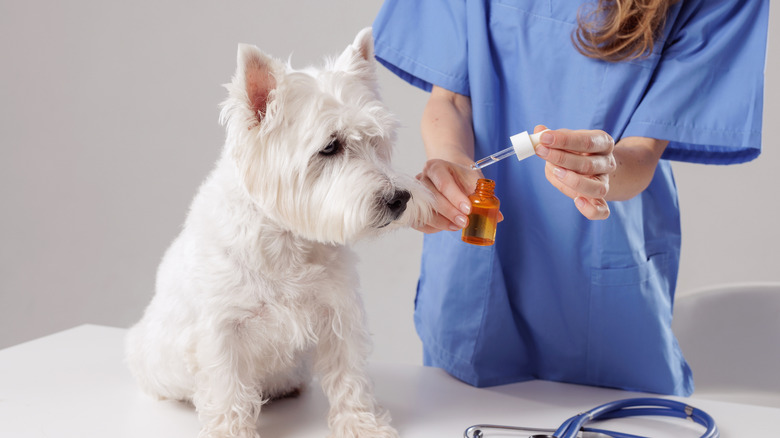About Polysporin Ear Drops For Dogs
What is Polysporin?
Polysporin is the brand name of an over-the-counter antibiotic skin ointment as well as antibiotic eye and ear drops manufactured by Johnson & Johnson. The generic name is bacitracin or polymyxin. Polysporin eye and ear drops are prescribed to treat external infections. Polysporin skin ointment works by killing some infection-causing bacteria.
The skin ointment is a combination of two antibiotics: bacitracin zinc and polymyxin B sulfate. It is sold over the counter in stores across the United States. The Polysporin eye drops also have two antibiotics, but they are different from the skin product. It includes polymyxin B and gramicidin. Polysporin Ear also contains both 10,000 IU of polymyxin B and 0.025 mg of gramicidin per milliliter.
Polysporin eye and ear products are available in 15-milliliter bottles over the counter in Canada, but they are not sold in the United States except on E-bay. In the United States, there is a prescription polymyxin B eye drop but it isn't referred to as Polysporin, as that name is more commonly used to refer to the over-the-counter products. Instead, it is called "polymyxin B sulfate and trimethoprim ophthalmic solution."
Is Polysporin safe for dogs?
In the United States, Polysporin is a skin antibiotic ointment that is used to treat human skin infections in superficial cuts. Polysporin skin ointment can be used safely for some minor cuts or injuries on a dog's skin but this should only be done with veterinary supervision. In other countries, it is also available in forms intended for use in humans to treat eye or ear infections. Since dog eye and ear infections are very different from those in humans, Polysporin Ear and Polysporin Eye will not be effective in treating canine conditions. These products are also not labeled for use in dogs. Never put Polysporin skin product into your dog's eyes or ears.
The bacteria involved in canine ear infections are often resistant to various antibiotics. Plus, dog ear infections often involve yeast overgrowth, which Polysporin Ear will not address. You will be able to treat your dog's ear infection more effectively with a product specifically made for use in canines.
Polysporin versus Neosporin use for dogs
Polysporin is less widely recommended by professionals in the United States than the triple antibiotic ointment Neosporin, which has one ingredient that Polysporin lacks: neomycin sulfate. Neosporin is available in two different versions. There is an over-the-counter skin product that is meant for use on minor cuts in humans, and there is also prescription Neosporin Ophthalmic. The prescription medication is available for humans and is also available in veterinary ophthalmic versions.
Over-the-counter Neosporin should never be used in a dog's eyes or in their ear canals. The only product that should be considered for treatment in these areas is the prescription triple antibiotic that was designed specifically for this use.
Where can you use Polysporin ondogs?
Polysporin skin ointment is meant for human skin abrasions and should never be used in your dog's eyes or for dog ear infections. It can sometimes be used on dogs for minor scrapes. Talk with your veterinarian first. It should not be used for skin infections like hot spots (pyoderma,) deep wounds, or rashes from serious allergic reactions.
Ear infections in dogs can be serious. Before treating an ear infection using any over-the-counter medication, talk with your veterinarian. They will do an ear cytology. This is a test where they take a swab of the discharge in your dog's ear, smear it onto a slide, stain it, and examine it under a microscope. Your veterinarian will then recommend the appropriate prescription-strength medication. Treating any infection with the incorrect antibiotic can cause it to get worse or become resistant to treatment. It can also result in permanent tissue damage or hearing loss.
If it's needed, your veterinarian may also order a bacterial culture and sensitivity. This is more commonly done in chronic ear infections that aren't resolving. One possible cause that this may reveal is antibiotic resistance. One of the more common causes of antibiotic resistance in humans and animals is the inappropriate use of antibiotics.
Polysporin alternatives for dogs
If your dog experiences a minor cut or abrasion, Polysporin is not necessary for wound care. You should always take the time to carefully rinse or wash the affected area using fresh water and an alcohol-free wipe from your first-aid kit or mild soap around the wound. Pay careful attention to make sure any debris, like broken glass, has been removed from the area and that any bleeding has stopped.
Natural treatment options preferred by some alternative veterinarians to clean and speed the healing of minor wounds include:
- Normal saline solution
- Alcohol-free witch hazel in small quantities (only once or twice a day)
- Turmeric
- Herbal tree rinses (chamomile or St. John's wort)
- Medical-grade honey ointment
Dog owners should talk with their veterinarian before using natural remedies, as they are not always a good choice. For example, witch hazel is drying and should not be used on dry skin because it can make the skin condition worse.
If a bandage is necessary to protect the area, one can be used, but many minor abrasions will heal best if left to "breathe" free from a bandage. Prevent your dog from licking the area using an Elizabethan collar if necessary.
Polysporin on dogs precautions
Neosporin and Polysporin topical ointments are both widely available in the United States, but they can both cause serious allergic reactions if ingested. Neither Neosporin nor Polysporin skin ointments should ever be applied to a dog's eyes or ears.
Over-the-counter products in general should never be used in a dog's eyes or ears without first talking to your veterinarian. Serious side effects may occur. If there is any sign of allergic reaction or swelling, call your veterinarian immediately. Polysporin Ear isn't effective as a treatment for ear mites, yeast infections, or other common causes of ear infections in dogs. It is advisable to have any dog ear discomfort or infection assessed and treated by a veterinarian.
Polymyxin B ear drops have been reported to cause a serious immune-mediated disorder called pemphigus vulgaris in dogs. Any prescribed veterinary medicine should only be given under the direction and supervision of a veterinarian. Regular appointments and check-ins will allow them to monitor your dog for any serious side effects.
The bottom line
Polysporin is a popular over-the-counter antibiotic. In the United States, it is only available as a skin ointment, but in other countries, it can also be purchased as an eye or ear treatment for people. Pet owners should know they are not labeled for use in dogs. While Polysporin is generally safe for minor scrapes and abrasions on dogs, it should never be used as an alternative to making a veterinary appointment. Never put Polysporin or Neosporin in your dog's eyes or ears. If your dog suffers from wounds, ear infections, or eye problems, you should contact your DVM.







